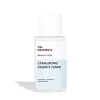What's inside
What's inside
 Key Ingredients
Key Ingredients

 Benefits
Benefits

 Concerns
Concerns

No concerns
 Ingredients Side-by-side
Ingredients Side-by-side

Water
Skin ConditioningButylene Glycol
HumectantPentylene Glycol
Skin ConditioningGlycerin
HumectantMethyl Gluceth-20
HumectantBifida Ferment Lysate
Skin ConditioningHydrolyzed Sodium Hyaluronate
Skin ConditioningCentella Asiatica Extract
CleansingDipotassium Glycyrrhizate
HumectantEthylhexylglycerin
Skin ConditioningCeramide Ns
Skin ConditioningCeramide AP
Skin ConditioningCeramide As
Skin ConditioningCeramide NP
Skin ConditioningCeramide EOP
Skin ConditioningLaminaria Digitata Extract
Skin ProtectingSodium Acetylated Hyaluronate
HumectantSodium Hyaluronate
HumectantSodium Hyaluronate Crosspolymer
HumectantTremella Fuciformis Sporocarp Extract
AntioxidantCalendula Officinalis Extract
Skin ConditioningInulin
Skin ConditioningAlpha-Glucan Oligosaccharide
CleansingEctoin
Skin ConditioningCollagen
MoisturisingCholesterol
Emollient1,2-Hexanediol
Skin ConditioningSorbitol
HumectantCetyl-Pg Hydroxyethyl Palmitamide
Skin ConditioningHydrogenated Lecithin
EmulsifyingHydroxyacetophenone
AntioxidantWater, Butylene Glycol, Pentylene Glycol, Glycerin, Methyl Gluceth-20, Bifida Ferment Lysate, Hydrolyzed Sodium Hyaluronate, Centella Asiatica Extract, Dipotassium Glycyrrhizate, Ethylhexylglycerin, Ceramide Ns, Ceramide AP, Ceramide As, Ceramide NP, Ceramide EOP, Laminaria Digitata Extract, Sodium Acetylated Hyaluronate, Sodium Hyaluronate, Sodium Hyaluronate Crosspolymer, Tremella Fuciformis Sporocarp Extract, Calendula Officinalis Extract, Inulin, Alpha-Glucan Oligosaccharide, Ectoin, Collagen, Cholesterol, 1,2-Hexanediol, Sorbitol, Cetyl-Pg Hydroxyethyl Palmitamide, Hydrogenated Lecithin, Hydroxyacetophenone
Water
Skin ConditioningButylene Glycol
HumectantGlycerin
HumectantGlycereth-26
HumectantErythritol
Humectant1,2-Hexanediol
Skin ConditioningHydroxyacetophenone
AntioxidantAcrylates/C10-30 Alkyl Acrylate Crosspolymer
Emulsion StabilisingHydroxyethylcellulose
Emulsion StabilisingTriethanolamine
BufferingDisodium EDTA
PEG-40 Hydrogenated Castor Oil
EmulsifyingStephania Tetrandra Root Extract
Skin ConditioningSodium Hyaluronate
HumectantBeta-Glucan
Skin ConditioningPropylene Glycol
HumectantBisabolol
MaskingHouttuynia Cordata Extract
Skin ConditioningCaprylic/Capric Triglyceride
MaskingHydrogenated Lecithin
EmulsifyingHexylene Glycol
EmulsifyingStearic Acid
CleansingCholesterol
EmollientZingiber Officinale Root Extract
MaskingCeramide NP
Skin ConditioningWater, Butylene Glycol, Glycerin, Glycereth-26, Erythritol, 1,2-Hexanediol, Hydroxyacetophenone, Acrylates/C10-30 Alkyl Acrylate Crosspolymer, Hydroxyethylcellulose, Triethanolamine, Disodium EDTA, PEG-40 Hydrogenated Castor Oil, Stephania Tetrandra Root Extract, Sodium Hyaluronate, Beta-Glucan, Propylene Glycol, Bisabolol, Houttuynia Cordata Extract, Caprylic/Capric Triglyceride, Hydrogenated Lecithin, Hexylene Glycol, Stearic Acid, Cholesterol, Zingiber Officinale Root Extract, Ceramide NP
 Reviews
Reviews

Ingredients Explained
These ingredients are found in both products.
Ingredients higher up in an ingredient list are typically present in a larger amount.
1,2-Hexanediol is a synthetic liquid and another multi-functional powerhouse.
It is a:
- Humectant, drawing moisture into the skin
- Emollient, helping to soften skin
- Solvent, dispersing and stabilizing formulas
- Preservative booster, enhancing the antimicrobial activity of other preservatives
Butylene Glycol (or BG) is used within cosmetic products for a few different reasons:
Overall, Butylene Glycol is a safe and well-rounded ingredient that works well with other ingredients.
Though this ingredient works well with most skin types, some people with sensitive skin may experience a reaction such as allergic rashes, closed comedones, or itchiness.
Learn more about Butylene GlycolCeramide NP is a type of ceramide and formally known as ceramide 3.
Ceramides are intercellular lipids naturally found in our skin that bonds dead skin cells together to create a barrier. They are known for their ability to hold water and thus are a great ingredient for dry skin.
Ceramides are an important building block for our skin barrier. A stronger barrier helps the skin look more firm and hydrated. By bolstering the skin ceramides act as a barrier against irritating ingredients. This can help with inflammation as well.
If you would like to eat ceramides, sweet potatoes contain a small amount.
Read more about other common types of ceramides here:
Ceramide AP
Ceramide EOP
Cholesterol is a class of organic molecules called lipids. It helps hydrate your skin and is essential to having a healthy skin barrier.
Our skin naturally contains cholesterol in the outermost layer. Besides cholesterol, it also contains ceramides and fatty acids. Cholesterol makes up about 1/4 of your skin's outer layer and barrier. Your skin barrier is responsible for keeping allergens and microbes out. Having a healthy skin barrier is also responsible for keeping your skin firm and plump.
Our bodies use cholestrol to create vitamin D, steroid hormones, and more.
Learn more about CholesterolGlycerin is already naturally found in your skin. It helps moisturize and protect your skin.
A study from 2016 found glycerin to be more effective as a humectant than AHAs and hyaluronic acid.
As a humectant, it helps the skin stay hydrated by pulling moisture to your skin. The low molecular weight of glycerin allows it to pull moisture into the deeper layers of your skin.
Hydrated skin improves your skin barrier; Your skin barrier helps protect against irritants and bacteria.
Glycerin has also been found to have antimicrobial and antiviral properties. Due to these properties, glycerin is often used in wound and burn treatments.
In cosmetics, glycerin is usually derived from plants such as soybean or palm. However, it can also be sourced from animals, such as tallow or animal fat.
This ingredient is organic, colorless, odorless, and non-toxic.
Glycerin is the name for this ingredient in American English. British English uses Glycerol/Glycerine.
Learn more about GlycerinHydrogenated Lecithin is created from the hydrogenation of lecithin (a group of phospholipids). Hydrogenation is a chemical reaction between hydrogen and another element.
This ingredient is an emollient and emulsifier. As an emollient, it helps soften skin by trapping moisture within. As an emulsifier, it prevents oil and water ingredients from separating.
Hydroxyacetophenone is antioxidant with skin conditioning and soothing properties. It also boosts the efficiency of preservatives.
This ingredient is not irritating or sensitizing.
Sodium Hyaluronate is hyaluronic acid's salt form. It is commonly derived from the sodium salt of hyaluronic acid.
Like hyaluronic acid, it is great at holding water and acts as a humectant. This makes it a great skin hydrating ingredient.
Sodium Hyaluronate is naturally occurring in our bodies and is mostly found in eye fluid and joints.
These are some other common types of Hyaluronic Acid:
Learn more about Sodium HyaluronateWater. It's the most common cosmetic ingredient of all. You'll usually see it at the top of ingredient lists, meaning that it makes up the largest part of the product.
So why is it so popular? Water most often acts as a solvent - this means that it helps dissolve other ingredients into the formulation.
You'll also recognize water as that liquid we all need to stay alive. If you see this, drink a glass of water. Stay hydrated!
Learn more about Water